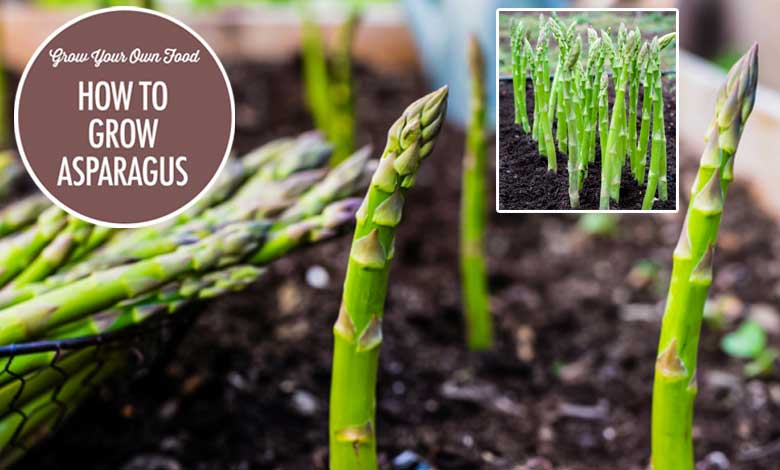How to Grow Asparagus and Harvest Asparagus Plant
Who doesn’t love asparagus and doesn’t want to grow asparagus of his own? It is one of the plants that greet us first in spring. And if you also love asparagus like me, don’t hesitate to start producing them. With your outmost care and ultimate effort, you can develop a beautiful asparagus bed. There is a good news that once you are able to develop a bed, it will last and produce the plant for several years up to 20-30 years. Also this beautiful plants will help you to enjoy your pastime as the plants are highly ornamental. So, no more additional talk; let’s learn how to grow asparagus.

Growing asparagus
Asparagus grows well in the temperate regions; at the same time, grows robustly in cold areas having a record of long winters. In spring, the young stems shoot as the temperature of the soil is about to 50 degrees F; the very stems are the edible part of asparagus. You won’t be able to harvest your asparagus at the first couple of seasons and perhaps it is the most important thing you need to remember. Allow the plants to get established well. Don’t worry, your patient is of worth enough. As I mention above, you’ll be able to harvest them for a long time once they are established well.
Varieties to try
As you know that the asparagus is male or female. Most often the males are preferred as they are three times more productive than the other. And if you are a gardener of zone 4-6, Jersey Giant, Jersey King and Jersey Knight will be the best choice.

If you are from a cooler reign, Guelph Millennium will befit. And for the warmer climates, there are some heat tolerant varieties i.s Apollo and UC-157. They produce well before the weather becomes too hot.
Preparing your bed
According to the older recommendation, gardeners needed to dig the bed 18” deep. They were said to refill the trench with the mixture of compost along with soil. But the gardeners of now a day should be thanking to Rutgers University of Jersey and elsewhere for the development of asparagus farming method and varieties. They are easy and less working to grow. About 6-12” of trench will do enough to produce twice as many spears from a plant. Again the hybrid asparagus is resistant to usual asparagus diseases: asparagus rust and fusarium root.

Ensure cleanliness of your beds from weed before starting plantation. If it takes almost one year to clean the area (grasses and other weeds), don’t hesitate to work for a long as a pre preparation of it.
Planting asparagus and care in-season
Plan accordingly as the crowns become usually available in early spring. If you think your bed is clean and weed free, create a 12” deep trench maintaining a foot of width. Plant your crowns 18” intervals. Apply a shovel of compost with a cup of organic fertilizer in your trench. Another good addition may be rock phosphate that will ensure sufficient phosphorus which is essential to strengthen the roots. Of course you won’t miss your only chance to fortify the root zone.

- Shape the soil into a little mound mixing your compost fertilizer with some garden soil.
- Place the crown of asparagus on top
- Around the sides, the roots should be draped down.
- Ensure that the crown is about to 6” below the soil surface.
- Apply some garden soil to cover the crown.
- Water the bed well.
- Apply some additional soil when the trench’s been filled back up at the time of shoots’ beginning to appear.
- Clean the weeds or grasses if they appear. Without doing so, you cannot reclaim the planting.
- Weed with outmost care and often.
- Ensure the safety of the roots as they are near to the surface of the soil. So, keep your eyes on avoiding damage them.
- Avoid planting other vegetables or greens with asparagus as it hates companions.
- Remember, asparagus grows well in wet and swamps lands.
- Maintain well moisture in order to get a good production.
- Apply drip irrigation or a soaker hose in cause of your living in a dry region.
- Water the asparagus regularly especially during the 1-5 years of maturing.
Diseases and pests of asparagus
| name | type | Identification marks | prevention |
| cutworms | pest | Cut the stems of young spears just above the ground level | Directly remove the worms using hands if you find them. Clean weeds and other plants. Have a consultation with nearest agro-officer if you find the problem acute before applying any pesticides. |
| Asparagus beetles | Pest | Bending in a hook shape, spears turn into brown. Damaged fruits or seeds along with defoliation | Remove beetles using hands directly. Ensure the disposal of plants in fall where you think the eggs might be housed or stored. |
| Fusarium crown rot | disease | Brown spots on crowns, stems or root. Yellow, wilted ferns, rotting spears. | Choose varieties that are resistant. Stop overharvesting. Plant new plants nearby infected site. |
| Asparagus rust | disease | Emerging spears have pale green spots. They become yellow or orange. In summer, there is brown blister. Brown ferns and reduced vigor resulting in defoliation. | Control over irrigation. Collect the affected plants and destroy. Select such variety that is resistant. Don’t plant new plant nearby and ensure good air circulation. |
How to harvest
If you want a productive bed of your asparagus, resist your greed. Collect only a few spears from a plant after the year of your planting. Harvest your asparagus for about two weeks and stop. Let the fronds be unfolded to feed the roots. The next year, harvest for three weeks and after that, for six weeks.

Harvest the spears at 5-8” height. Collect them before the tips get loosen to ensure softness. Cut the spears off above the ground level. Continue harvesting as long as there yield only spears of half inches in diameter once your bed is well established. Let your spears develop naturally if the harvesting season is over in spring or early summer. Let your bed be weeded watered and mulched. Remember, the fronds become yellow at the time of fall arrives. This is the best opportunity for you to cut the fronds about 1” above the ground level. Remove the fronds from the area to ensure from pests like asparagus beetle. Also this will ensure cleanliness for your bed to be ready in the next spring.
If you have a family of four members, only twenty-five asparagus plants will do enough to meet with the demand.
“how to grow asparagus, what to grow in April, how does asparagus grow, how to plant asparagus, how to harvest asparagus, how to grow asparagus from cuttings, how to grow grapes from cuttings, how long does asparagus take to grow, how to grow hot peppers, how do you grow asparagus, how long does it take to grow asparagus, small veg garden, how to plant asparagus seeds, how to grow asparagus, tomato companion plants, how long does it take for asparagus to grow, small vegetable garden, vegetable garden uk, gardening tips, how to grow asparagus, latest vegetable garden. “






